Egypt
Recipes
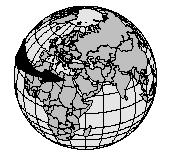
1 GEOGRAPHIC SETTING AND ENVIRONMENT
The Arab Republic of Egypt is located in the northeastern region of the African continent, bordering both the Mediterranean and Red Seas. The climate is arid and dry and most of the country receives less than one inch of rainfall each year. The Mediterranean may offer Egypt's northern coastline up to eight inches of rainfall each year, and keeps year-round temperatures cooler than the inland deserts. The widespread lack of rainfall makes it extremely difficult to grow crops. Egypt has no forests and only 2 percent of the land is arable (land that can be farmed).
The well-known Nile River, the longest river in the world, runs north and south through eastern Egypt and empties into the Mediterranean Sea. The Nile River Valley, which includes the capital city of Cairo, is the most fertile land in Egypt. Approximately 95 percent of the country's population lives alongside the Nile River. However, overcrowding in this region is threatening Egypt's wildlife and endangering the Nile's water supply.
2 HISTORY AND FOOD
Thousands of years ago, ancient Egyptians left evidence of their love for food. Well-preserved wall paintings and carvings have been discovered on tombs and temples, depicting large feasts and a variety of foods. Many of these ancient foods are still eaten in Egyptian households today. Peas, beans, cucumbers, dates, figs, and grapes were popular fruits and vegetables in ancient times. Wheat and barley, ancient staple crops, were used to make bread and beer. Fish and poultry were also popular. Dried
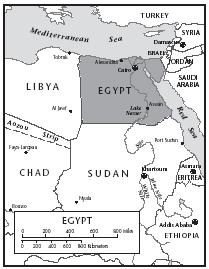
The unique Egyptian cuisine has been influenced throughout history, particularly by its neighbors from the Middle East. Persians (modern-day Iraqis), Greeks, Romans (modern-day Italians), Arabs, and Ottomans (from modern-day Turkey) first influenced Egyptian cuisine thousands of years ago. More recently, the foods of other Arabic people in the Middle East such as the Lebanese, Palestinians, Syrians, as well as some foods from Europe, have affected the Egyptian diet. However, Egyptian cuisine maintains its uniqueness. After thousands of years, rice and bread remain staple foods, and molokhiyya (a spinach-like vegetable) and ful mudammas (cooked, creamy fava beans), a national dish, are nearly as popular as long ago.
Ful Mudammas (Broad Beans in Sauce)
Ingredients
- 2 cans (15-ounce each) cooked fava beans
- 6 cloves garlic, or to taste
- 1 teaspoon salt, or to taste
- 1 Tablespoon lemon juice, freshly squeezed
- ¼ cup olive oil
- 1½ Tablespoons parsley, minced
- Garnish, such as radishes, hard-boiled eggs, chopped scallions, pita bread (toasted and cut into wedges)
Procedure
- Press the garlic cloves through a garlic press into a medium bowl.
- Mash the garlic and salt together.
- Next, add the lemon juice, olive oil, and parsley to the garlic mixture and combine thoroughly.
- Drain the beans well, rinse, and put beans into a large pot over low heat.
- Add garlic mixture and stir with a wooden spoon to combine thoroughly.
- Serve warm with the garnishes arranged on a platter.
- Each person is served a plateful of Ful Mudammas and adds the garnishes of his or her choice.
Serves 4 to 6.
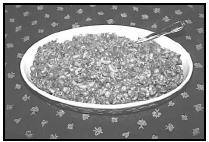
3 FOODS OF THE EGYPTIANS
Egypt has a variety of national dishes. Ful (pronounced "fool," bean paste), tahini (sesame paste), koushari (lentils, macaroni, rice, and chickpeas), aish baladi (a pita-like bread), kofta (spicy, minced lamb), and kebab (grilled lamb pieces) are the most popular.
Koushari (Lentils, Macaroni, Rice, and Chickpeas)
Ingredients
- 1 cup lentils
- 1 teaspoon salt
- 1 cup elbow macaroni
- 1 cup rice
- 1 can (15-ounce) chickpeas (also called ceci)
- 2 Tablespoons olive oil
S AUCE :
- 1 cup canned tomato puree
- ¼ cup olive oil
- 2 onions
- 1 garlic clove, or to taste
Procedure
- Prepare lentils: Place the lentils in a sieve and rinse thoroughly. Place them in a large saucepan with 3 cups of water and 1 teaspoon salt.
- Heat until the water begins to boil. Lower the heat, and simmer for about 1 hour until lentils are tender. Drain and set the lentils aside.
- Prepare the macaroni: Fill the same saucepan with water (add salt if desired). Heat until the water begins to boil.
- Add the macaroni and boil about 12 to 15 minutes, until macaroni is tender. Drain and set the macaroni aside. (It is okay to combine the macaroni and lentils.)
- Prepare the rice: Heat the 2 Tablespoons of olive oil in the same saucepan. Add the rice and cook for 2 or 3 minutes, thoroughly coating the rice with oil.
- Add 2 cups of water and heat until the water begins to boil. Cover the saucepan and simmer until the rice is tender, about 15 minutes.
- Remove from heat and allow to cool for about 5 minutes.
- Assemble koushari: Drain chickpeas and rinse. Add chickpeas, lentils, and macaroni to cooked rice and toss very gently with a fork.
- Make sauce: Peel the onions and cut them in half lengthwise. Slice each half crosswise into thin slices.
- Heat ¼ cup olive oil in a skillet. Add onions and cook, stirring often with a wooden spoon, until onions are golden brown.
- Add garlic clove and cook 1 or 2 more minutes. Stir in tomato puree and heat until bubbly.
- Now pour the sauce over the lentil mixture and heat over very low heat for about 5 minutes, until completely warm.
- Serve with pita bread.
Serves 4 to 6.
Aish , the Arabic name for bread, means "life." It accompanies most meals and is served in various forms. The most common bread is pita, usually made with whole wheat (or sometimes white) flour. Long, skinny French-style loaves of bread are also widely eaten throughout the country. Traditional Egyptian cheeses, as well as feta imported from neighboring Greece, are frequently served alongside bread at meals.
Despite the country's dry climate and shortage of arable land (land that can be farmed), Egypt grows a variety of fresh fruits. Mohz (bananas), balah (dates), burtu'aan (oranges), battiikh (melon), khukh (peaches), berkuk (plums), and 'anub (grapes) are commonly grown.
Ful (creamy bean paste made from fava beans), one of the country's several national dishes, is a typical breakfast meal. It is often served in a spicy sauce, topped with an egg. Lunch, normally served between 2 P.M. and 4 P.M. , usually includes meat or fish, rice, bread, and seasonal vegetables. Salad ( mezza, or mezze if more than one is served), topped with typical Middle Eastern fare such as olives, cheese, and nuts, may also be eaten. Meat (usually lamb, chicken, fish, rabbit, or pigeon), vegetables, and bread make up a typical dinner in Egypt. Tea and a dessert, such as baklava (honey pastry), basbousa (cream-filled cake), or konafa (cooked batter stuffed with nuts), are familiar after-dinner treats.
Tea and coffee are widely consumed. Egypt's numerous coffee and teahouses brew very strong coffee and tea (often mint tea), usually offering both full of sugar. Coffeehouses are typically filled with men who gather to play dominoes or backgammon. Coffee is served saada or "bitter" (no sugar) or ziyada or "very sweet." Egyptians also enjoy a drink called sahleb, made from wheat, milk, and chopped nuts.
For a typical dessert, Egyptians may serve mint tea with sugar and a sweet, flaky pastry called baklava.
Shai (Mint Tea) and Baklava
Ingredients
- 1 package mint tea (loose or in tea bags)
- Sugar
- 4 to 6 cups water (depending on how many people are being served)
Procedure
- Bring water to a boil.
- If using loose tea, measure 1 teaspoon of tea leaves into a teapot for each person being served.
- Otherwise, place one tea bag per person into the teapot.
- Pour boiling water over tea.
- Allow to steep (soak) for about 3 minutes.
- Pour tea into cups. (In Egypt, small glass tumblers are used.)
- If loose tea is used, allow the tea leaves to settle to the bottom of the pot, and pour carefully to avoid disturbing them.
- Add 4 or 5 teaspoonsful of sugar to each cup.
- Enjoy with a piece of baklava, purchased from a bakery.
Serves 4 to 6.
Lemon and Garlic Potato Salad
Ingredients
- 2 pounds of red potatoes, scrubbed but with skin left on
- ½ cup parsley, chopped
- 4 garlic cloves, minced
- Juice of 1½ lemons
- 1 Tablespoon vegetable oil
- Salt and pepper, to taste
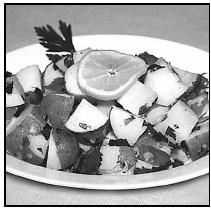
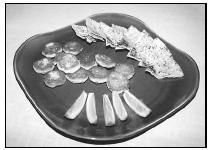
Procedure
- Boil potatoes until tender (½ hour to 1 hour, or until a fork can easily pierce the skin) and let cool.
- Add parsley, garlic cloves, lemon juice, oil, and salt and pepper; mix well.
- Chill and serve.
Serves 4.
Gebna Makleyah (Oven-Fried Cheese)
Ingredients
- 1 cup firm feta cheese, crumbled, or traditional Egyptian cheese such as labna or gebna
- 1 Tablespoon flour
- 1 egg
- Salt and freshly ground black pepper, to taste
- Olive oil
- Lemon wedges and pita bread cut into triangles, for serving

Procedure
- Preheat oven to 400°F.
- Place the cheese, flour, egg, salt, and pepper in a bowl and mix well with very clean hands.
- Roll the mixture into 1-inch balls.
- If the mixture seems too loose to hold the ball shape, add a little more flour.
- If the mixture seems too dry, add a bit of lemon juice, vinegar, or water.
- Pour 2 or 3 Tablespoons olive oil onto a cookie sheet to grease.
- Arrange the cheese balls on the cookie sheet, rolling them around to coat thoroughly with the oil.
- Bake 5 minutes.
- Wearing an oven mitt, open the oven door and shake the cookie sheet to prevent cheese balls from sticking and to turn them.
- Bake 5 more minutes, until golden brown.
- Remove with a spatula and drain on absorbent paper.
- Serve warm with lemon wedges and triangles of pita bread.
Serves 4 to 6.
4 FOOD FOR RELIGIOUS AND HOLIDAY CELEBRATIONS
Approximately 90 percent of Egyptians are Muslims, which means they practice the religion of Islam. The most important time of the year for Muslims is a monthlong holiday called Ramadan. During the month of Ramadan (the ninth month on the Islamic calendar, usually November or December), Muslims fast (do not eat or drink) from sunrise to sunset, and think about people around the world who do not have enough food. Muslim families will often come together to prepare hearty meals, including a variety of sweets, after sunset. Muslims end Ramadan with a three-day celebration called Eid al-Fitr.
Eid al-Adha, a three-day long "great feast," is another important holiday for Muslims. In recognition of the Bible story of Abraham's sacrifice of his son, Jacob, families will sacrifice (kill) a sheep or a lamb. The animal is slaughtered and cooked whole on a spit over an open fire, and some of the meat is usually given to poorer families. These animals are also sacrificed on other important occasions, such as births, deaths, or marriages.

Throughout the year, several moulids may take place. A moulid is a day (or as long as a week) celebrating the birthday of a local saint or holy person. Several events take place during this time. Food stands decorating the town's streets are usually set up near the holy person's tomb. Cairo, the capital of Egypt, celebrates at least three moulids every year. The largest moulid, Moulid el Nabit, commemorates the birthday of Muhammad and takes place in Cairo in early August.
Just under 10 percent of Egypt's population are Christians, whose most important holiday is Easter, falling in either March or April. It is common for families to come together to share a hearty meal, much as Christians worldwide do. Egyptian Christians observe the Orthodox calendar, which places Christmas on January 7 each year.
Bamia (Sweet and Sour Okra)
Ingredients
- 1 pound small okra pods
- 2 Tablespoons olive oil
- 1 Tablespoon honey
- Salt and freshly ground black pepper, to taste
- 1 Tablespoon lemon juice, freshly squeezed
- ½ cup water
Procedure
- Wash the okra and pat it dry with paper towels.
- Discard any blemished or hard pods.
- Heat the olive oil in a heavy saucepan and sauté the okra in the oil for 3 to 5 minutes, turning each pod once.
- Add the honey, salt, pepper, lemon juice, and water. Cover, lower the heat, and simmer for 15 minutes, adding more water if necessary.
- Serve hot.
Serves 4 to 6.
'Irea (Cinnamon Beverage)
Ingredients
- 2 cinnamon sticks
- 2 teaspoons sugar, or to taste
- 1 cup cold water
- Mixed nuts
Procedure
- Place the cinnamon and sugar in a small saucepan with the cold water and bring to a boil, stirring occasionally.
- Lower the heat and allow the mixture to simmer for 10 minutes, or until it is brownish.
- Remove the cinnamon sticks and pour the drink into a cup.
- Serve with mixed nuts sprinkled into the cup.
Makes 1 cup.
Khoshaf
Ingredients
- 1 cup dried prunes
- 1 cup dried apricots
- 1 cup dried small figs, halved
- 1½ cups raisins
- 1 cup sugar, or to taste
- 2½ cups boiling water
Procedure
- Place all the fruits in a bowl and mix together gently.
- Sprinkle the sugar on top of the dried fruits.
- Carefully pour the boiling water into the bowl, cover, and allow to cool to room temperature.
- Refrigerate for several hours, or overnight if possible. ( Khoshaf is best when allowed to marinate overnight or for several hours before serving.)
Serves 4.
Lettuce Salad
Ingredients
- 1 small head of lettuce, shredded
- ¾ cup orange juice
- Pinch of salt
- 1½ teaspoons pepper, or to taste
Procedure
- Toss lettuce with orange juice.
- Season with a pinch of salt and pepper.
Makes 6 to 8 servings.
5 MEALTIME CUSTOMS
Dining customs vary throughout the country and between different religions. When guests are in the presence of Muslims (who make up approximately 90 percent of Egypt's population), there are some general guidelines one should follow. The left hand is considered unclean and should not be used for eating, feet should always been tucked under the table, and alcohol and pork should not be requested.
When invited to be a guest in an Egyptian household, it is polite for guests to bring a small gift to the host, such as flowers or chocolate, to show their appreciation for the meal. Before dinner, cocktails (often nonalcoholic) are frequently served. This is a time for socializing and becoming acquainted. Mezze (salads and dips) would also be served at this time. When dinner is ready, usually between 9 P.M. and 10 P.M. , guests seat themselves and food is placed in the middle of the table. Bread will almost always accompany meals, which may include vegetables, rice dishes, soups, and meat dishes. Following dinner, guests will move into another room and enjoy coffee or mint tea. Guests should always compliment the cook.
Most Egyptian peasants cannot afford a large meal. Their diet includes vegetables, lentils, and beans. Meat, which is more costly, is eaten on special occasions. Most middle-class families eat a similar diet, but add more expensive ingredients when they can afford to. All social classes, however, enjoy quick bites at Egyptian cafes or street vendors. Traditional teahouses will serve tea in tall glasses (rather than teacups) and cafes normally offer strong, sweet Turkish coffee. Street vendors sell a variety of inexpensive foods, including ful (fava beans) and koushari (a macaroni, rice, and lentil dish) as a lunchtime favorite. Vendors also sell a variety of asiir (fresh-squeezed juices) made from fruits like banana, guava, mango, pomegranate, strawberry, from sugar cane, and even hibiscus flowers.
Spinach with Garlic
Ingredients
- 1 medium onion, chopped
- 1 Tablespoon vegetable oil
- 2 garlic cloves, chopped
- 1 can (15-ounce) tomato sauce
- 10 ounces frozen spinach, thawed
- ½ cup water
- 2 cups cooked rice
Procedure
- Heat oil in a large skillet.
- Add onions and cook, stirring with a wooden spoon, until onions are softened.
- Add the garlic and continue to cook for 2 minutes.
- Add the tomato sauce and bring to a boil.
- Simmer for 10 minutes on low heat.
- Add the spinach and water, and heat to a boil again.
- Cover and simmer on low heat for 15 minutes.
- Serve warm over cooked rice.
Serves 4.
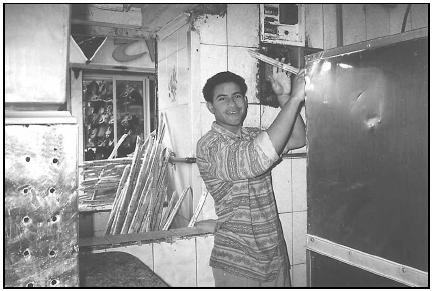
6 POLITICS, ECONOMICS, AND NUTRITION
In 1999, agriculture made up approximately 16 percent of Egypt's economy, employing about one-third of all Egyptians. However, Egypt's agriculture is also contributing to the slowing of economic growth. A shortage of arable land (land that can be farmed) has become a serious problem. The lack of farmable land has caused Egyptian farmers to move to other countries.
Irrigation necessary to grow its major crops, such as sugar cane, barley, wheat, corn, cotton, and rice, is also a growing problem. The Nile River is Egypt's main water source for both drinking and irrigation, and overuse could risk the country's delicate water supply. More than two thousand years ago, the Greek historian Herodotus wrote: "Egypt is the gift of the Nile." Without the Nile River, Egypt would be virtually dry and crops to prevent hunger and malnutrition could not grow. Much in part to the irrigation from the Nile River, Egypt has one of the lowest childhood malnourishment rates on the continent. About 9 percent of children younger than five were considered malnourished.
7 FURTHER STUDY
Books
APA Productions. Insight Guide: Egypt . New York: Langenscheidt Publishers, 1999.
Balkwill, Richard. Food and Feasts in Ancient Egypt. New York: New Discovery, 1994.
Haag, Michael. Cadogan Guide to Egypt . London: Cadogan Books, 1998.
Hachten, Harva. Best of Regional African Cooking . New York: Hippocrene Books, Inc., 1998.
Imeme, Sally-Anne, and Stefan Cucos, eds. Odyssey Guides: Egypt . Chicago: Passport Books, 1997.
Lonely Planet: Egypt . 5 th ed. Victoria, Australia: Lonely Planet Publications Pty Ltd., 1999.
Mallos, Tess. The Complete Middle East Cookbook. Boston: Tuttle, 1993.
Web Sites
Recipes for Food and Cuisine in Egypt. [Online] Available http://touregypt.net/recipes/ (accessed January 28, 2001).
i recommend this
thanks thatnjs jjr